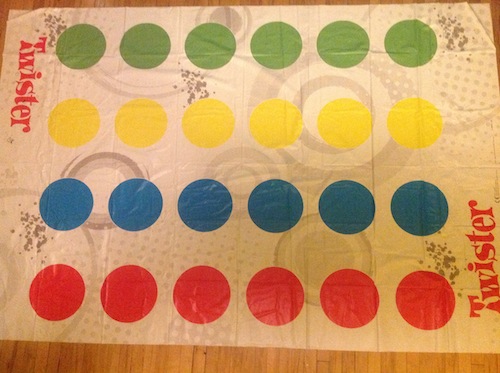Tabitha received a Twister game for her recent birthday (7 years old!) She enjoys a version of the game in which one person spins and the other follows instructions until, as Tabitha puts it with much delight, the cookie crumbles.
The players switch roles for the next round. No score is kept.
She wants to play a round one recent Sunday evening. I have been writing, so I have her set it up in the kitchen while I finish up.
She comes back to me with questions.
Tabitha (7 years old): Daddy! What’s six plus six plus six plus six?
Me: Wait. How many sixes?
T: Four.
Me: Twenty-four.
T: Yes! I counted them right!
Me: Huh?
She takes me into the kitchen to show me the Twister board.
T: See? One, two, three, four, five, six.
She is counting the green dots in one row.
T: Then one, two, three, four
She is counting the rows.
Me: So four sixes is 24. Nice. Can I show you something cool? It’s also six fours. See? One, two, three, four.
I am counting the dots in one column—each a different color.
Me: Then one, two, three, four, five, six.
I am counting the columns.
Me: So four sixes and six fours are the same.
T: Like the dominoes.
She is referring to a recent homework assignment in which dominoes were used to demonstrate that 6+4 is the same as 4+6, and that this is true as a general principle about addition.
So what do we learn?
Rows and columns are fun, fun, fun.
Malke Rosenfeld of Math in Your Feet reminds me regularly that children love to play in structured space. She uses blue tape on the floor for her math/dance lessons and has noticed that children love to play freely in and around the spaces created by the tape (seriously: click that link, have a read and then go buy some painter’s tape!). The same thing is true for the Twister board. It creates a structured space for Tabitha to explore at a scale that allows her to use her whole body. That’s a good time for a seven-year-old.
But children don’t always notice the rows and columns in an arrangement like the Twister board. They need to learn to notice it. This is an important step on the path to learning multiplication. The fact that our conversation began with “What is 6+6+6+6 ?” tells me that Tabitha notices the rows and the columns. She knows that the answer to 6+6+6+6 should be the same as her count. By introducing the language of “four sixes” and “six fours”, I am trying to help her notice the multiplication structure underlying her ideas.
Starting the conversation
Arrange things in rows and columns. When you do, the whole thing is called an array.
Point out arrays in the world. Count the number in each row together, and count the number of rows. Notice together whether the numbers switch if you count the number in each column and count the columns. Does eight rows of six become six columns of eight? Does this happen for all numbers?
Here are some of my favorite arrays.

